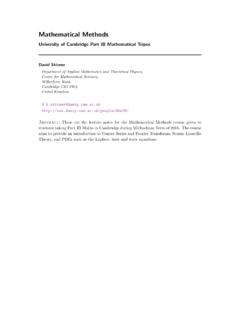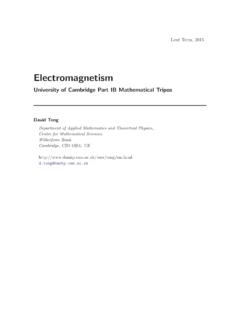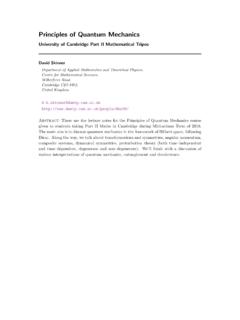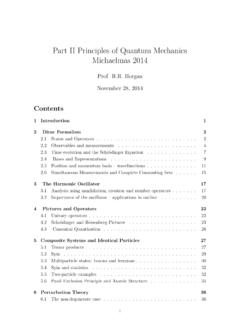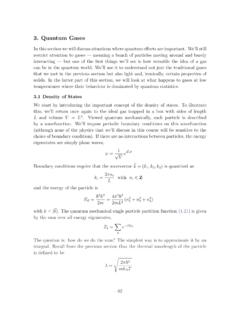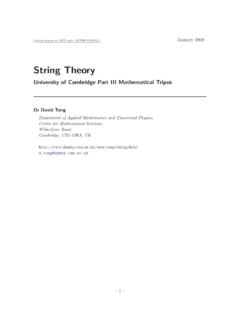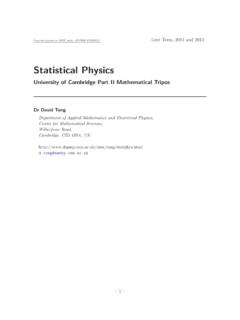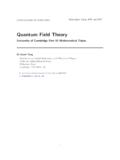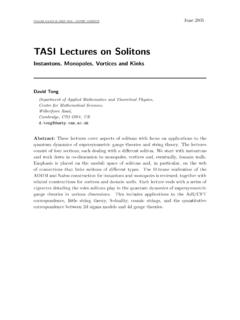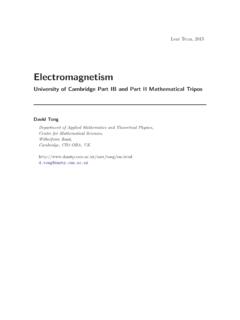Transcription of Quantum Field Theory - University of Cambridge
1 Preprint typeset in JHEP style - HYPER VERSIONM ichaelmas Term, 2006 and 2007 Quantum Field TheoryUniversity of Cambridge Part III Mathematical TriposDr David TongDepartment of Applied Mathematics and Theoretical Physics,Centre for Mathematical Sciences,Wilberforce Road, Cambridge , CB3 OWA, 1 Recommended Books and Resources M. Peskin and D. Schroeder,An Introduction to Quantum Field TheoryThis is a very clear and comprehensive book, covering everything in this course at theright level. It will also cover everything in the Advanced Quantum Field Theory course, much of the Standard Model course, and will serve you well if you go on todo research.
2 To a large extent, our course will follow the first section of this is a vast array of further Quantum Field Theory texts, many of them withredeeming features. Here I mention a few very different ones. S. Weinberg,The Quantum Theory of Fields, Vol 1 This is the first in a three volume series by one of the masters of Quantum Field takes a unique route to through the subject, focussing initially on particles ratherthan fields. The second volume covers material lectured in AQFT . L. Ryder, Quantum Field TheoryThis elementary text has a nice discussion of much of the material in this course.
3 A. Zee, Quantum Field Theory in a NutshellThis is charming book, where emphasis is placed on physical understanding and theauthor isn t afraid to hide the ugly truth when necessary. It contains many gems. M Srednicki, Quantum Field TheoryA very clear and well written introduction to the subject. Both this book and Zee sfocus on the path integral approach, rather than canonical quantization that we developin this are also resources available on the web. Some particularly good ones are listedon the course webpage: and Scales41.
4 Classical Field Dynamics of Example: The Klein-Gordon Example: First Order Final Example: Maxwell s , Locality, s Example: Translations and the Energy-Momentum Example: Lorentz Transformations and Angular Hamiltonian Formalism192. Free Simple Harmonic Free Scalar Cosmological Casimir Scalar Heisenberg Feynman s Quantum Mechanics43 1 3. Interacting Interaction s First Look at Example: Meson s Example: Recovering the s Example: Nucleon of Scattering Yukawa Diagrams and Amputated We Measure: Cross Sections and Decay s Golden s Diagrams and Vacuum Green s Functions to S-Matrices794.
5 The Dirac Spinor an Dirac Weyl and Conserved Wave Examples102 2 Useful Formulae: Inner and Outer Products1035. Quantizing the Dirac Glimpse at the Spin-Statistics s Hole Feynman Example: Putting Spin on Nucleon Rules for Yukawa Potential Coupling1226. Quantum s Quantization of the Electromagnetic to to to Feynman in Coulomb 3 AcknowledgementsThese lecture notes are far from original. My primary contribution has been to borrow,steal and assimilate the best discussions and explanations I could find from the vastliterature on the subject.
6 I inherited the course from Nick Manton, whose notes form thebackbone of the lectures. I have also relied heavily on the sources listed at the beginning,most notably the book by Peskin and Schroeder. In several places, for example thediscussion of scalar Yukawa Theory , I followed the lectures of Sidney Coleman, usingthe notes written by Brian Hill and a beautiful abridged version of these notes due toMichael thanks to the many who helped in various ways during the preparation of thiscourse, including Joe Conlon, Nick Dorey, Marie Ericsson, Eyo Ita, Ian Drummond,Jerome Gauntlett, Matt Headrick, Ron Horgan, Nick Manton, Hugh Osborn and JenniSmillie.
7 My thanks also to the students for their sharp questions and sharp eyes inspotting typos. I am supported by the Royal Society. 4 0. Introduction There are no real one-particle systems in nature, not even few-particlesystems. The existence of virtual pairs and of pair fluctuations shows thatthe days of fixed particle numbers are over. Viki WeisskopfThe concept of wave-particle duality tells us that the properties of electrons andphotons are fundamentally very similar.
8 Despite obvious differences in their mass andcharge, under the right circumstances both suffer wave-like diffraction and both canpack a particle-like the appearance of these objects in classical physics is very different. Electronsand other matter particles are postulated to be elementary constituents of Nature. Incontrast, light is a derived concept: it arises as a ripple of the electromagnetic Field . Ifphotons and particles are truely to be placed on equal footing, how should we reconcilethis difference in the Quantum world?
9 Should we view the particle as fundamental,with the electromagnetic Field arising only in some classical limit from a collection ofquantum photons? Or should we instead view the Field as fundamental, with the photonappearing only when we correctly treat the Field in a manner consistent with quantumtheory? And, if this latter view is correct, should we also introduce an electron Field ,whose ripples give rise to particles with mass and charge? But why then didn t Faraday,Maxwell and other classical physicists find it useful to introduce the concept of matterfields, analogous to the electromagnetic Field ?
10 The purpose of this course is to answer these questions. We shall see that the secondviewpoint above is the most useful: the Field is primary and particles are derivedconcepts, appearing only after quantization. We will show how photons arise from thequantization of the electromagnetic Field and how massive, charged particles such aselectrons arise from the quantization of matter fields. We will learn that in order todescribe the fundamental laws of Nature, we must not only introduce electron fields,but also quark fields, neutrino fields, gluon fields, W and Z-boson fields, Higgs fieldsand a whole slew of others.
